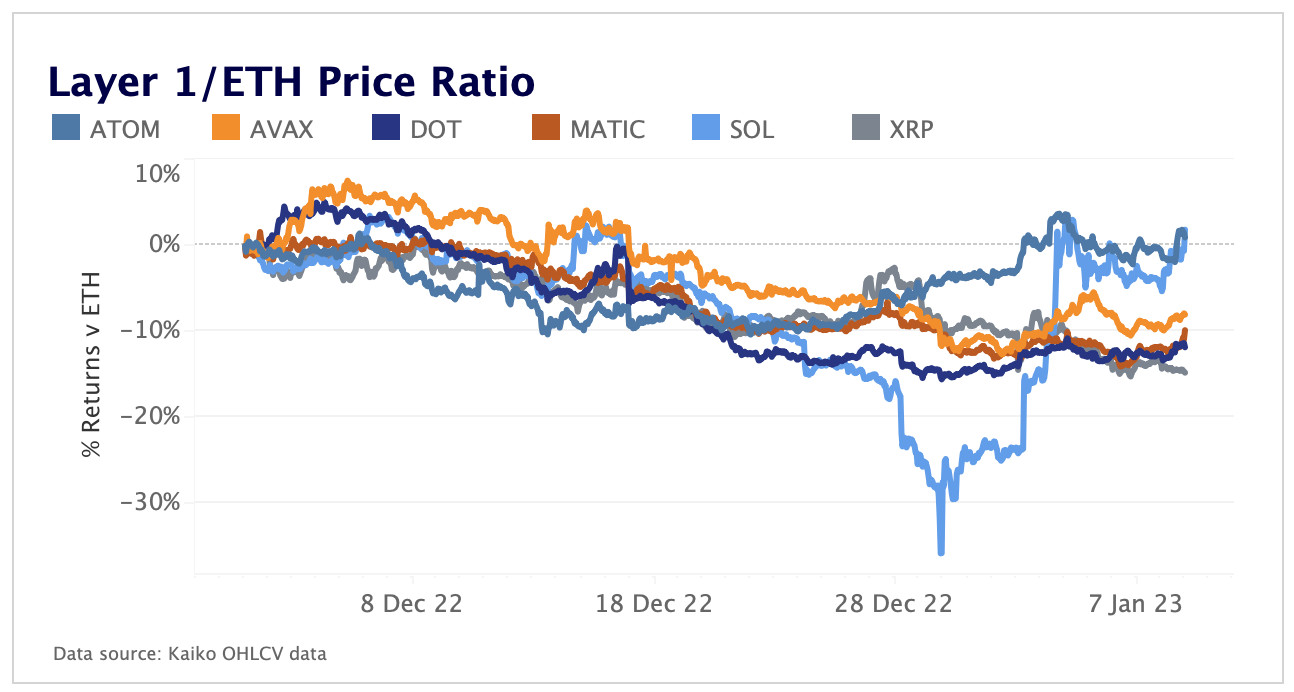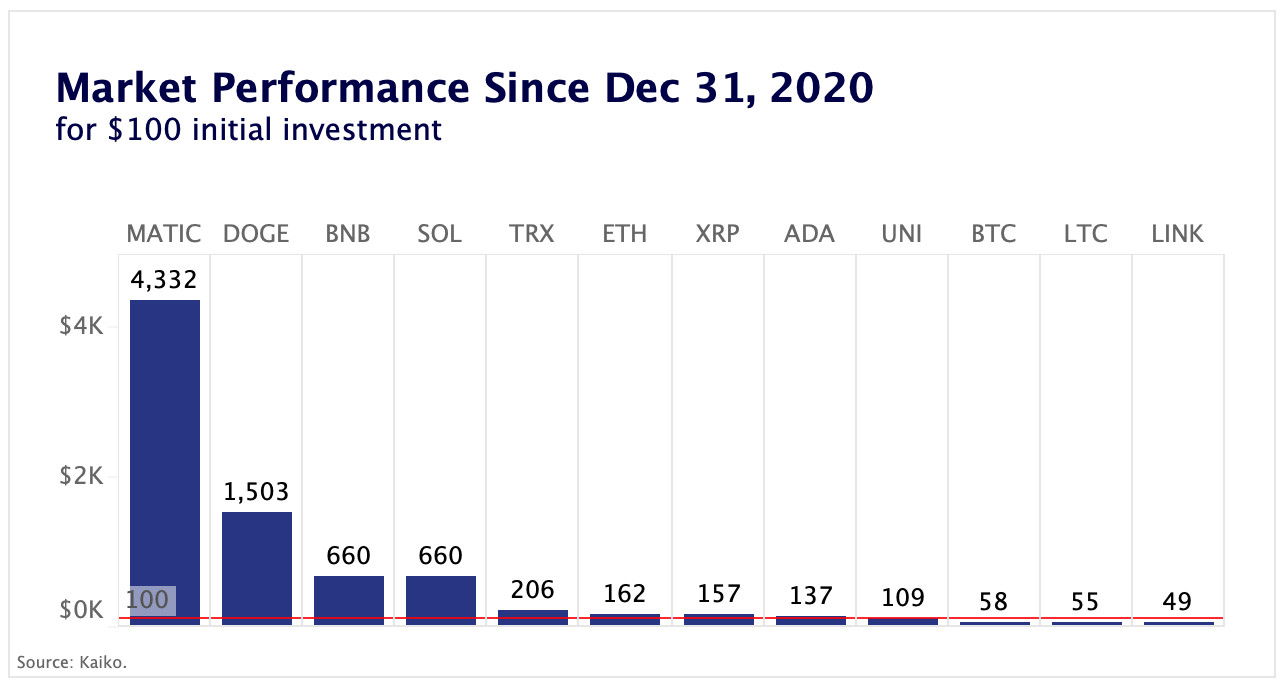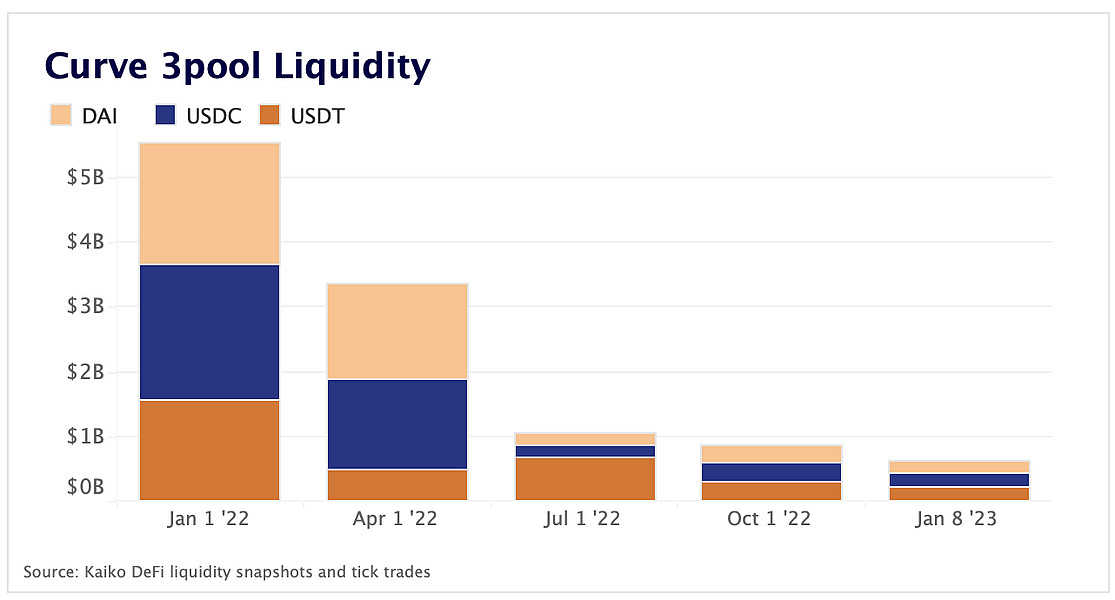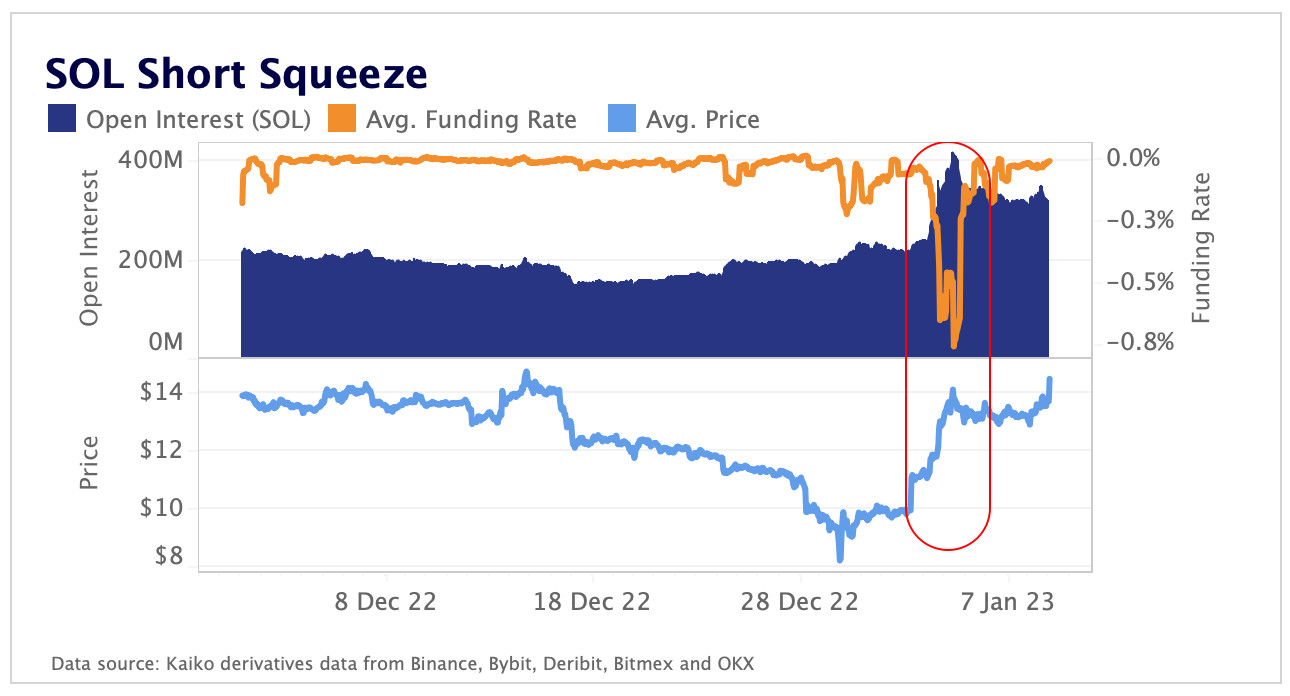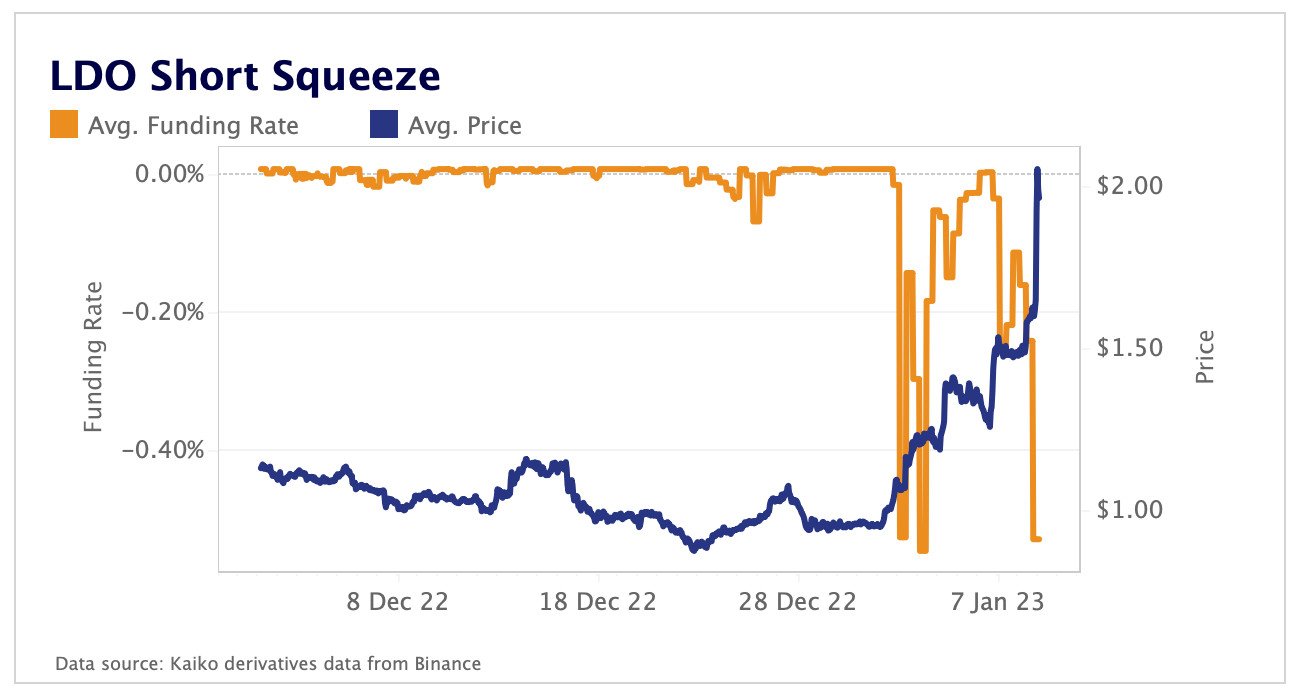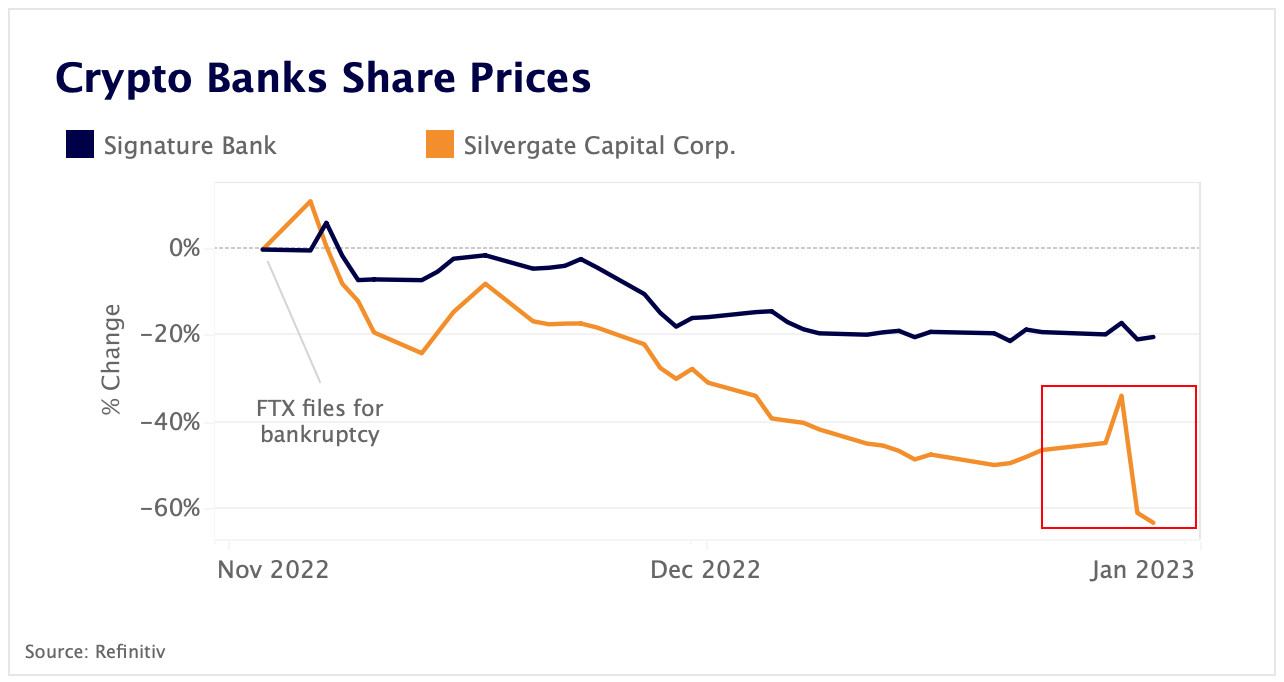A summarizing review of what has been happening at the crypto markets of the past week. A look at trending sectors, liquidity, volatility, spreads and more. The weekly report in cooperation with market data provider Kaiko.
The last 7 days at the cryptocurrency markets:
- Price Movements: Most Layer 1 tokens have struggled versus ETH since December, but SOL and ATOM have recently outperformed.
- Market Liquidity: Curve’s 3pool – made up of USDT, USDC, and DAI – has seen its total value locked fall from $5.5bn to just $600mn over the past year.
- Derivatives: Both SOL and LDO experienced a short squeeze as each token unexpectedly rallied.
- Macro Trends: Silvergate Bank's share price tumbled 43% in just one day last week after new revelations from the WSJ.
A bullish first week of 2023

Bitcoin's (BTC) and Ethereum (ETH) closed the first week of 2023 up 3% and 8% respectively. However, while price action was positive, negative headlines continued to roll in. Digital Currency Group is being investigated by the DOJ for its transfers with subsidiary Genesis, while Coinbase was fined $50mn over their failure to scale their compliance checks as business boomed. Meanwhile, Silvergate, one of crypto’s biggest banks, reportedly lost $700mn in a race to cover over $8bn in withdrawals following the collapse of FTX. In more positive news, the Ethereum network is pushing ahead with a key software update called Shanghai, enabling staked ETH withdrawals in March.
Layer 1s struggle vs ETH, but SOL and ATOM outperform
Layer 1 tokens are struggling as the bear market persists. Alt layer 1s usually outperform ETH when crypto markets rally largely due to their higher beta. However, since December 1 the majority of alt L1s are underperforming ETH, with only ATOM and SOL outperforming out of the tokens chosen. SOL in particular has staged a remarkable comeback since the end of the year, when it was down 35% compared to ETH for the month of December. Since then, SOL has recovered and is now outperforming ETH by 2% since the start of the month. The recovery in SOL was largely driven by a positive Vitalik tweet, surging interest in the Solana-native token BONK, and a derivatives short squeeze which we will discuss later in this newsletter.
Some altcoins remain significantly above their end-2020 value
Altcoins have held their value from the end of 2020 surprisingly well. An initial investment of $100 in Polygon’s MATIC at the start of the crypto bull run would have still earned an impressive return and was worth more than $4300 as of the end of 2022. In contrast, $100 investment of BTC would have been valued at just $58. Overall, most altcoins showed resilience to the crypto winter with ETH, XRP, ADA and UNI still above their end-2020 value. However, the fact that more speculative assets such as Dogecoin still offer triple digit returns relative to the start of the crypto bull run could also mean that there is froth in the market and valuations have not yet bottomed.
Stablecoins had volatile market caps in 2022
The loss of confidence following the collapses of Terra in May and FTX in November has had a strong impact on stablecoins, with the three largest stablecoins by market cap registering divergent outflows and inflows. We look at the market cap change for USDT, USDC and BUSD in the aftermath Terra's collapse (from May until November) and FTX collapse (between November and December).
Tether (USDT) was the only stablecoin to see its market cap fall after both market events. Binance's BUSD registered inflows between May and November but its market cap has dropped sharply in the last two months of the year after the exchange suffered a crisis of confidence. USDC was the only stablecoin to record an increase in market cap after the collapse of FTX.
Overall, this suggests that unnerved investors are now attributing higher risk premium to stablecoins which lack transparency and regulation. In addition to losing their safe-haven appeal, stablecoins are facing strong competition from other traditional asset classes with U.S. Treasuries offering attractive risk-free returns.
Curve's 3pool liquidity remains low, but has rebalanced
Curve’s 3pool – made up of USDT, USDC, and DAI – has seen its total value locked fall from $5.5bn to just $600mn over the past year. The biggest drop happened following the Terra collapse and crypto credit criss, which caused USDT to surge to over 60% percent of the pool, a far cry from the ideal 33% and a sign that investors preferred holding USDC and DAI. USDT passed this stress test, and by the beginning of Q4 the 3pool was almost perfectly balanced.
Then came the FTX/Alameda collapse, and again the pool shrunk from $900mn to $600mn. Throughout the collapse, USDT’s share of the pool again increased to 50%, but has since rebalanced.
Since the start of the year, the ratio of the pool has been rebalanced by swaps, with USDC to USDT swaps outpacing swaps of USDT to USDC by almost $120mn, correcting the balance. This trend was especially pronounced over the weekend.
Coinbase sees a spike in BTC activity over the holidays
Traders have been abnormally active on the largest U.S. exchange Coinbase despite a general drop off in crypto trade volumes. Coinbase’s BTC spot market share hit an all-time high of over 60% last month relative to other exchanges that offer a USD trading pair. When looking at the buy and sell orders for all trades greater than 5 BTC, it is clear that large whale traders were responsible for the surge in trade volumes. In particular, there were a handful of very large BTC sell orders.
This is particularly interesting as we observed a similar trend a year ago in Dec 2021 - a large amount of buy and sell orders were executed ahead of the Dec 31 option expiry, pushing Coinbase’s BTC market share to an all-time high relative to other USD markets. The trend suggests that Coinbase is gaining market share relative to other regulated venues.
LDO's illiquidity helps boost price
LDO, the governance token for the decentralized finance protocol Lido, gained over 60% in the last week as investors look to take part in the liquid staking narrative ahead of the Shanghai update of the Ethereum network in March. This update will enable withdrawals for staked ETH, allowing investors to freely stake and un-stake their ETH. Liquid staking derivatives, such as stETH, stand to gain from withdrawals being enabled as the illiquidity risk associated with these tokens will be significantly reduced.
LDO is quite illiquid on centralized exchanges, with only $500k-$1mn of market depth within 2% of the mid price. This illiquidity could have helped propel the price upwards as demand for the governance token picked up, with over $110m of daily volume yesterday: a more than 10x increase on the daily volume figure for LDO at the end of December.
A week of short squeezes for SOL and LDO
The biggest story in derivatives markets so far in 2023 has been the wave of short squeezes that hit heavily shorted tokens such as SOL and LDO. SOL saw its open interest in native units double since the start of the year as the funding rate dipped sharply negative to -0.8%. This is the equivalent of shorts paying long positions in SOL 2.4% a day for the privilege of being short SOL. This buildup of positions on the short side meant that once SOL bounced in price to start the year, these shorts were liquidated and funding returned back to neutral territory.
A similar buildup in short pressure occurred for LDO, whose funding rate dipped to -0.5%, or -1.5% daily. LDO has been one of the best performing tokens in crypto to start the year, up over 60%. Looking at funding rates for LDO, this bias to the short side built up as LDO began to rally, and reverted back to neutral as LDO price action took a breather. However, the short sellers returned and the funding rate reverted back to -0.5% yesterday and LDO surged in price shortly after.
It’s very possible that the negative funding rate is largely driven by a disproportionate surge in spot prices for LDO. As we saw earlier, LDO is quite illiquid on centralised exchanges, so when demand picks up, spot exchanges struggle to meet demand and the price of LDO surges. As funding rates are the difference between spot prices and future prices, when spot prices rise faster than futures prices the funding rate goes further negative, which could be the case with LDO.
Confidence crisis takes its toll on crypto banks
Shares of Silvergate Capital Corp. (Silvergate Bank's parent company) tumbled by a whopping 43% in just a day last week after revelations from the WSJ that the bank faced massive withdrawals of over $8bn following the collapse of FTX. Silvergate, which managed nearly $12bn in crypto-linked deposits before the run, is the largest crypto-focused bank in the U.S. providing critical market infrastructure to the digital asset industry. Its shares have plummeted by nearly 80% since November, underperforming other crypto-exposed banks. Bearish sentiment around Silvergate has been building as it has been criticized for accepting FTX and Alameda deposits and processing wire transfers for companies and individuals to the exchange.
Silvergate has reported it currently holds enough cash to cover all remaining crypto-related deposits but is recalibrating its expenses and evaluating its revenue structure in anticipation of a prolonged period of low deposits. Other regulated lenders with ties to the crypto industry such as Signature Bank have also suffered losses and announced plans to intentionally reduce their crypto exposure.
This could significantly impact institutional players as the crypto market is underbanked - only a handful of lenders offer custody, real-time transaction processing and large-scale dollar deposits for crypto companies.


